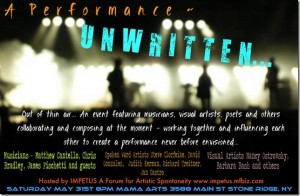I had no hint from the announcement that an intense new love affair awaited me. It was called “A Performance Unwritten,” for an event on May 31 at a venue called MAMA Arts in Stone Ridge, New York. Its premise was that artists in various media and forms, most of whom had never worked together before, were going to create an evening of entirely improvised art. Well, no thanks, but that doesn’t sound like my bag, man…
…except that my poet friend Judith Kerman was one of the artists involved. And it was on an evening when I had nothing else planned. And it might be something that my wife, who has Alzheimer’s Disease, would enjoy, since it sounded as though it would be visually stimulating and she usually enjoys music.
When we got to Stone Ridge, my suspicions were immediately aroused by the venue. I’d never been there before, and it didn’t look like a very well-organized place. But the event attracted a fairly good-sized audience, and as soon as the trio of musicians started to play I knew I was in for an enjoyable evening, since they were quite good. As the performance progressed, some of the spoken word improvisations were involving (especially, I must say, Judy’s), some less interesting, but the music kept things lively.
And then there were the painters, one on each side of the hall. One of them was doing some pretty interesting work. The other looked at first as though she was just splashing and dabbing paint on a large black board, using several methods to get paint onto the board not including a brush. Just as I decided the work was going to be nothing but abstraction, she put her hand into white paint and pressed it down, and as she lifted it off I realized that her handprint was at the end of an arm and she was creating a figure.

That moment of recognition threw a shock into my system. I was reminded of the time, half a century ago, when I heard my first Cecil Taylor record. A jazz critic friend played it for me, telling me he thought Taylor was the next great thing in jazz. I listened with increasing puzzlement as some guy seemed to be throwing his hands at random around the piano keyboard, until I suddenly realized that an impossibly complex figure ran up and down the keyboard and was then repeated exactly. The understanding that Taylor was in complete control of everything he played forced me to listen with different ears.
I had that same realization about the work of Nancy Ostrovsky. Throughout the remainder of the performance I couldn’t take my eyes off her. After she finished the first painting, she took it off the easel, rested briefly, and then started throwing paint around again. This time, she was creating a picture of the musicians and some dancers who briefly participated in the performance.

It was art love at first sight. At the end of the performance, I rushed over to Ostrovsky and asked how much she wanted for the paintings. The price she quoted seemed quite reasonable. I handed her some money as a down payment on the one I had decided I wanted. (It turned out, not surprisingly, to be a little less than it’s costing me to frame it!)
Perhaps I should have bought the figure. It was the painting that gave me that thrill of discovery. But I decided I would have more fun looking at the musicians. I look forward to having them as companions for a long time, and to seeing a lot more of Nancy Ostrovsky’s work. When I went to her studio to collect my painting–she wouldn’t let it go immediately because she wanted it to dry properly–I saw a lot more of her work. One impressive item was a copy of a poster for a Dizzy Gillespie concert, inscribed to her by Gillespie.
